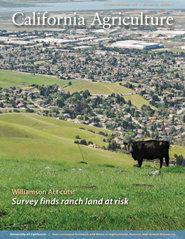All Issues

Williamson Act cuts:
Survey finds ranch land at risk
Cover:
State budget cuts have dramatically reduced funding for the Williamson Act, the conservation law that provides property tax relief for the owners of 15 million acres of farms and rangeland. In a survey of Central Valley ranchers, researchers found that landowners planned to sell 20% of their total acres if Williamson Act contracts were eliminated (page 131); 76% of those owners predicted buyers would develop the land for nonagricultural uses. Shown is an Angus cow grazing in Mission Peak Regional Preserve, which overlooks the City of Fremont and the San Francisco Bay. Photo by Sheila Barry
October-December 2012
Volume 66, Number 4
Volume 66, Number 4
News and opinion
RESEARCH NEWS
UC Desert Research and Extension Center celebrates 100 years
Three-quarters of surveyed ranchers who would sell land if they lost Williamson Act tax benefits predicted that it would be developed for nonagricultural uses.





